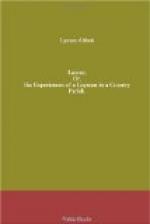A village I have called it. It certainly is neither town nor city. There is a little centre where there is a livery stable, and a country store with the Post Office attached, and a blacksmith shop, and two churches, a Methodist and a Presbyterian, with the promise of a Baptist church in a lecture-room as yet unfinished. This is the old centre; there is another down under the hill where there is a dock, and a railroad station, and a great hotel with a big bar and generally a knot of loungers who evidently do not believe in the water-cure. And between the two there is a constant battle as to which shall be the town. For the rest, there is a road wandering in an aimless way along the hill-side, like a child at play who is going nowhere, and all along this road are scattered every variety of dwelling, big and little, sombre and gay, humble and pretentious, which the mind of man ever conceived of,—and some of which I devoutly trust the mind of man will never again conceive. There are solid substantial Dutch farm-houses, built of unhewn stone, that look as though they were outgrowths of the mountain, which nothing short of an earthquake could disturb; and there are fragile little boxes that look as though they would be swept away, to be seen no more forever, by the first winter’s blast that comes tearing up the gap as though the bag of Eolus had just been opened at West Point and the imprisoned winds were off with a whoop for a lark. There are houses in sombre grays with trimmings of the same; and there are houses in every variety of color, including one that is of a light pea-green, with pink trimmings and blue blinds. There are old and venerable houses, that look as though they might have come over with Peter Stuyvesant and been living at Wheathedge ever since; and there are spruce little sprigs of houses that look as though they had just come up from New York to spend a holiday, and did not rightly know what to do with themselves in the country. There are staid and respectable mansions that never move from the even tenor of their ways; and there are houses that change their fashions every season, putting on a new coat of paint every spring; and there is one that dresses itself out in summer with so many flags and streamers that one might imagine Fourth of July lived there.
All nations and all eras appear also to be gathered here. There are Swiss cottages with overhanging chambers, and Italian villas with flat roofs, and Gothic structures with incipient spires that look as though they had stopped in their childhood and never got their growth, and Grecian temples with rows of wooden imitations of marble pillars of Doric architecture, and one house in which all nations and eras combine—a Grecian porch, a Gothic roof, an Italian L, and a half finished tower of the Elizabethan era, capped with a Moorish dome, the whole approached through the stiffest of all stiff avenues of evergreens, trimmed in the latest French fashion. That is Mr. Wheaton’s residence, the millionaire of Wheathedge. I wish I could say he was as Catholic as his dwelling house.




